Analysis of File Systems on Mobile Devices: Types and Compatibility
VerifiedAdded on 2023/06/07
|5
|895
|386
Report
AI Summary
This report provides a comprehensive overview of file systems on mobile devices, detailing how files are named, stored, and retrieved. It highlights the importance of file systems in managing the increasing data capacities of mobile phones. The report discusses various file systems such as FAT, GFS, HFS, NTFS, and UDF, explaining their unique logical structures and properties. It also includes a table that outlines the file systems supported by different mobile devices and operating systems, including iPhone, Fire Tablet, Kindle Tablet, Android Phones, and Windows CE devices. The report references academic sources, emphasizing the evolution and adaptation of file systems to meet the demands of modern mobile technology. Desklib provides access to this document and many other solved assignments.
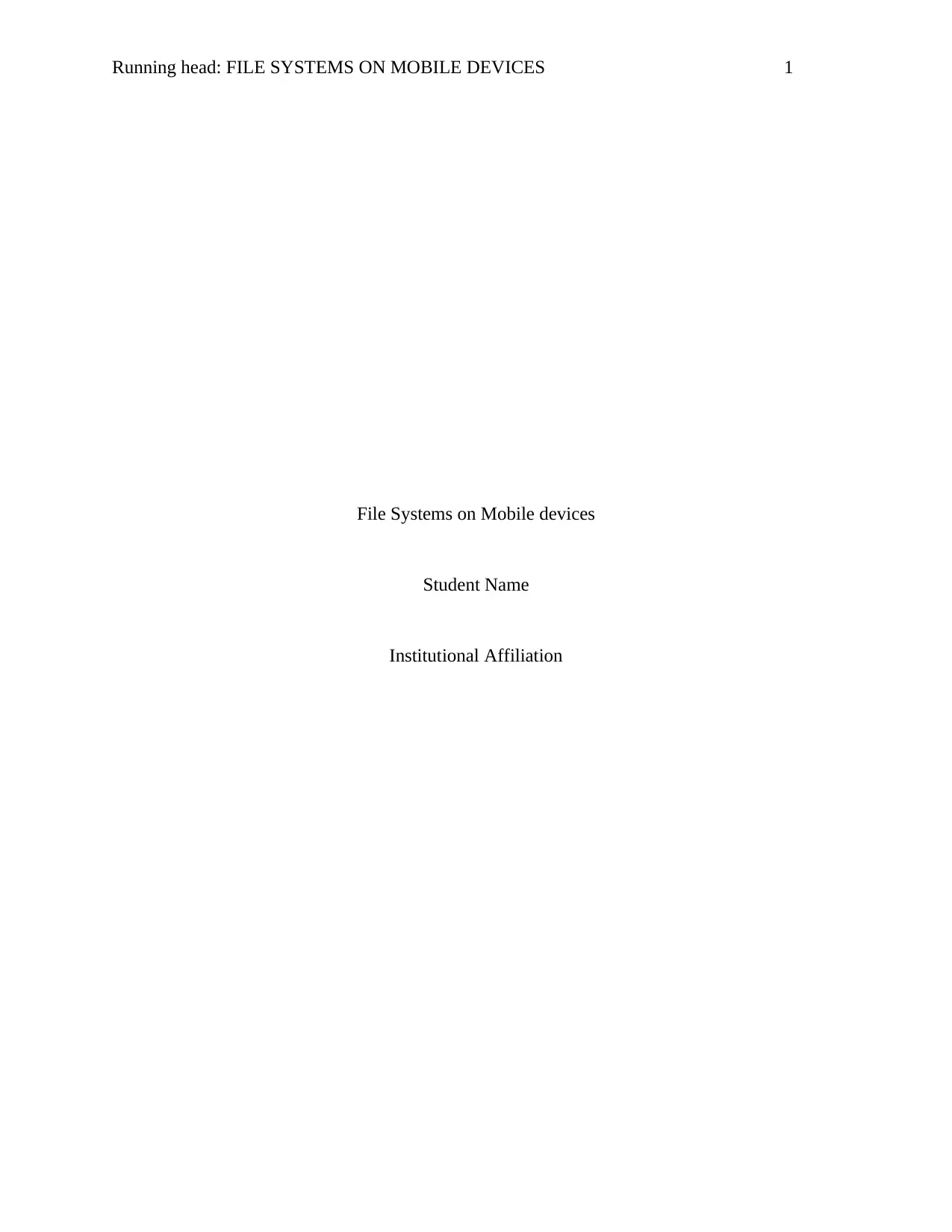
Running head: FILE SYSTEMS ON MOBILE DEVICES 1
File Systems on Mobile devices
Student Name
Institutional Affiliation
File Systems on Mobile devices
Student Name
Institutional Affiliation
Paraphrase This Document
Need a fresh take? Get an instant paraphrase of this document with our AI Paraphraser
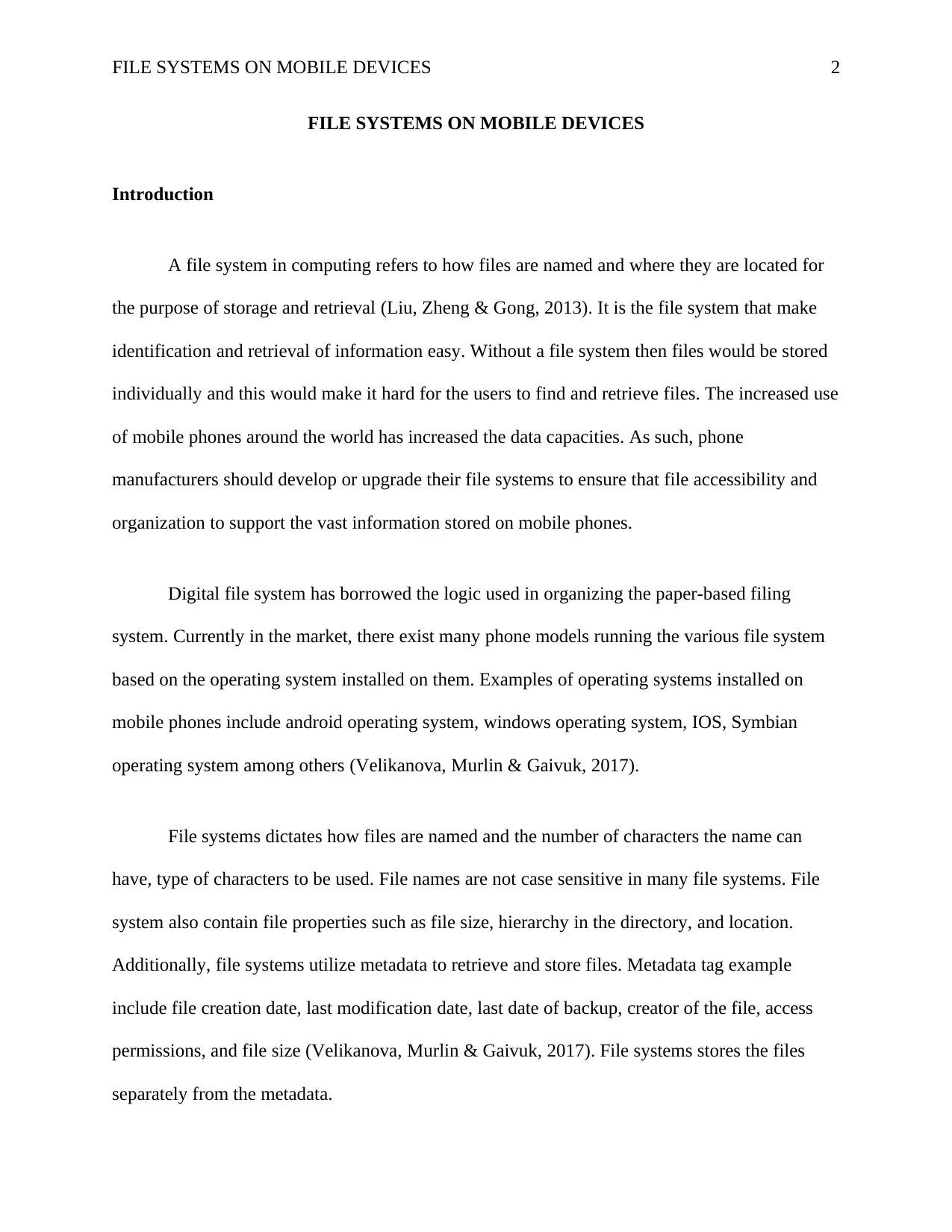
FILE SYSTEMS ON MOBILE DEVICES 2
FILE SYSTEMS ON MOBILE DEVICES
Introduction
A file system in computing refers to how files are named and where they are located for
the purpose of storage and retrieval (Liu, Zheng & Gong, 2013). It is the file system that make
identification and retrieval of information easy. Without a file system then files would be stored
individually and this would make it hard for the users to find and retrieve files. The increased use
of mobile phones around the world has increased the data capacities. As such, phone
manufacturers should develop or upgrade their file systems to ensure that file accessibility and
organization to support the vast information stored on mobile phones.
Digital file system has borrowed the logic used in organizing the paper-based filing
system. Currently in the market, there exist many phone models running the various file system
based on the operating system installed on them. Examples of operating systems installed on
mobile phones include android operating system, windows operating system, IOS, Symbian
operating system among others (Velikanova, Murlin & Gaivuk, 2017).
File systems dictates how files are named and the number of characters the name can
have, type of characters to be used. File names are not case sensitive in many file systems. File
system also contain file properties such as file size, hierarchy in the directory, and location.
Additionally, file systems utilize metadata to retrieve and store files. Metadata tag example
include file creation date, last modification date, last date of backup, creator of the file, access
permissions, and file size (Velikanova, Murlin & Gaivuk, 2017). File systems stores the files
separately from the metadata.
FILE SYSTEMS ON MOBILE DEVICES
Introduction
A file system in computing refers to how files are named and where they are located for
the purpose of storage and retrieval (Liu, Zheng & Gong, 2013). It is the file system that make
identification and retrieval of information easy. Without a file system then files would be stored
individually and this would make it hard for the users to find and retrieve files. The increased use
of mobile phones around the world has increased the data capacities. As such, phone
manufacturers should develop or upgrade their file systems to ensure that file accessibility and
organization to support the vast information stored on mobile phones.
Digital file system has borrowed the logic used in organizing the paper-based filing
system. Currently in the market, there exist many phone models running the various file system
based on the operating system installed on them. Examples of operating systems installed on
mobile phones include android operating system, windows operating system, IOS, Symbian
operating system among others (Velikanova, Murlin & Gaivuk, 2017).
File systems dictates how files are named and the number of characters the name can
have, type of characters to be used. File names are not case sensitive in many file systems. File
system also contain file properties such as file size, hierarchy in the directory, and location.
Additionally, file systems utilize metadata to retrieve and store files. Metadata tag example
include file creation date, last modification date, last date of backup, creator of the file, access
permissions, and file size (Velikanova, Murlin & Gaivuk, 2017). File systems stores the files
separately from the metadata.
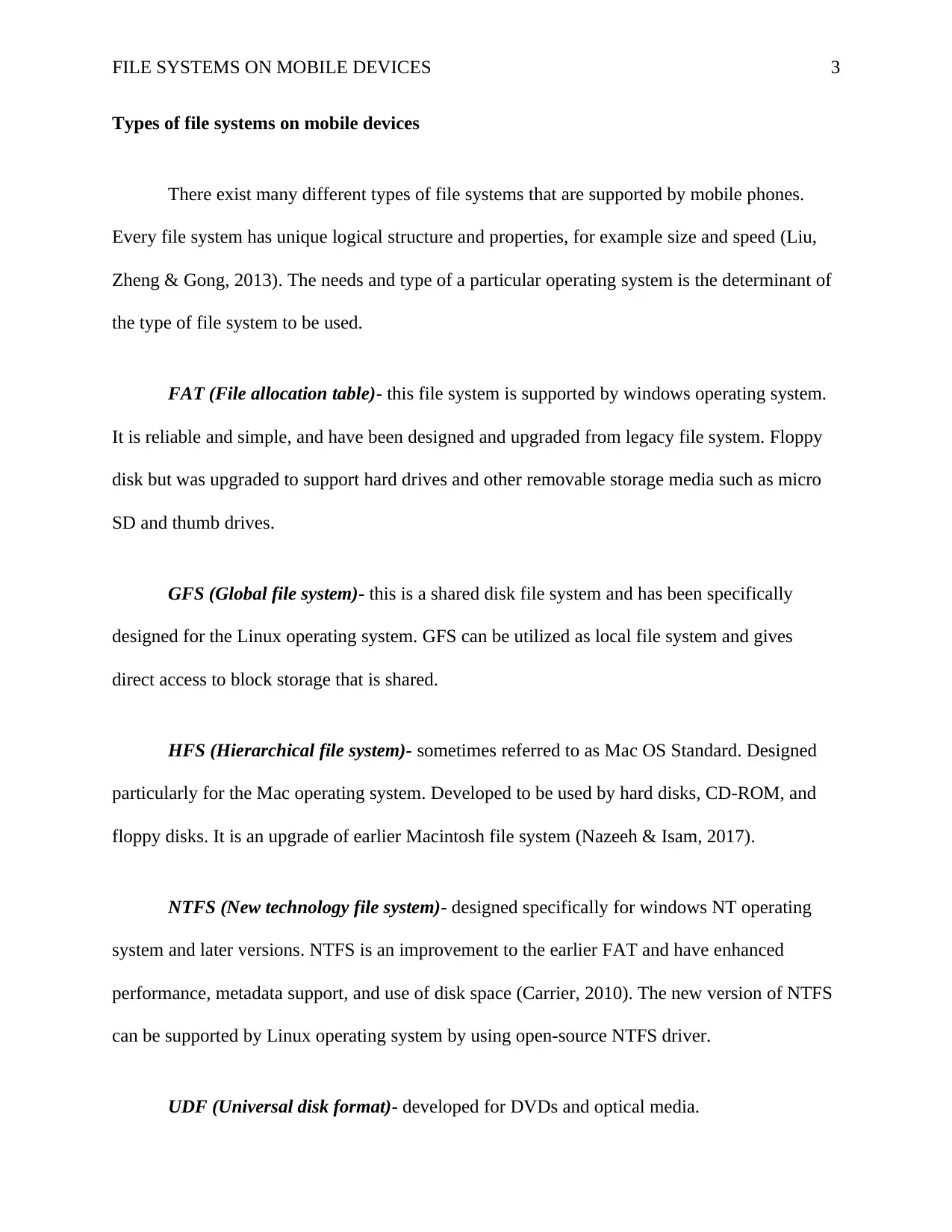
FILE SYSTEMS ON MOBILE DEVICES 3
Types of file systems on mobile devices
There exist many different types of file systems that are supported by mobile phones.
Every file system has unique logical structure and properties, for example size and speed (Liu,
Zheng & Gong, 2013). The needs and type of a particular operating system is the determinant of
the type of file system to be used.
FAT (File allocation table)- this file system is supported by windows operating system.
It is reliable and simple, and have been designed and upgraded from legacy file system. Floppy
disk but was upgraded to support hard drives and other removable storage media such as micro
SD and thumb drives.
GFS (Global file system)- this is a shared disk file system and has been specifically
designed for the Linux operating system. GFS can be utilized as local file system and gives
direct access to block storage that is shared.
HFS (Hierarchical file system)- sometimes referred to as Mac OS Standard. Designed
particularly for the Mac operating system. Developed to be used by hard disks, CD-ROM, and
floppy disks. It is an upgrade of earlier Macintosh file system (Nazeeh & Isam, 2017).
NTFS (New technology file system)- designed specifically for windows NT operating
system and later versions. NTFS is an improvement to the earlier FAT and have enhanced
performance, metadata support, and use of disk space (Carrier, 2010). The new version of NTFS
can be supported by Linux operating system by using open-source NTFS driver.
UDF (Universal disk format)- developed for DVDs and optical media.
Types of file systems on mobile devices
There exist many different types of file systems that are supported by mobile phones.
Every file system has unique logical structure and properties, for example size and speed (Liu,
Zheng & Gong, 2013). The needs and type of a particular operating system is the determinant of
the type of file system to be used.
FAT (File allocation table)- this file system is supported by windows operating system.
It is reliable and simple, and have been designed and upgraded from legacy file system. Floppy
disk but was upgraded to support hard drives and other removable storage media such as micro
SD and thumb drives.
GFS (Global file system)- this is a shared disk file system and has been specifically
designed for the Linux operating system. GFS can be utilized as local file system and gives
direct access to block storage that is shared.
HFS (Hierarchical file system)- sometimes referred to as Mac OS Standard. Designed
particularly for the Mac operating system. Developed to be used by hard disks, CD-ROM, and
floppy disks. It is an upgrade of earlier Macintosh file system (Nazeeh & Isam, 2017).
NTFS (New technology file system)- designed specifically for windows NT operating
system and later versions. NTFS is an improvement to the earlier FAT and have enhanced
performance, metadata support, and use of disk space (Carrier, 2010). The new version of NTFS
can be supported by Linux operating system by using open-source NTFS driver.
UDF (Universal disk format)- developed for DVDs and optical media.
⊘ This is a preview!⊘
Do you want full access?
Subscribe today to unlock all pages.

Trusted by 1+ million students worldwide
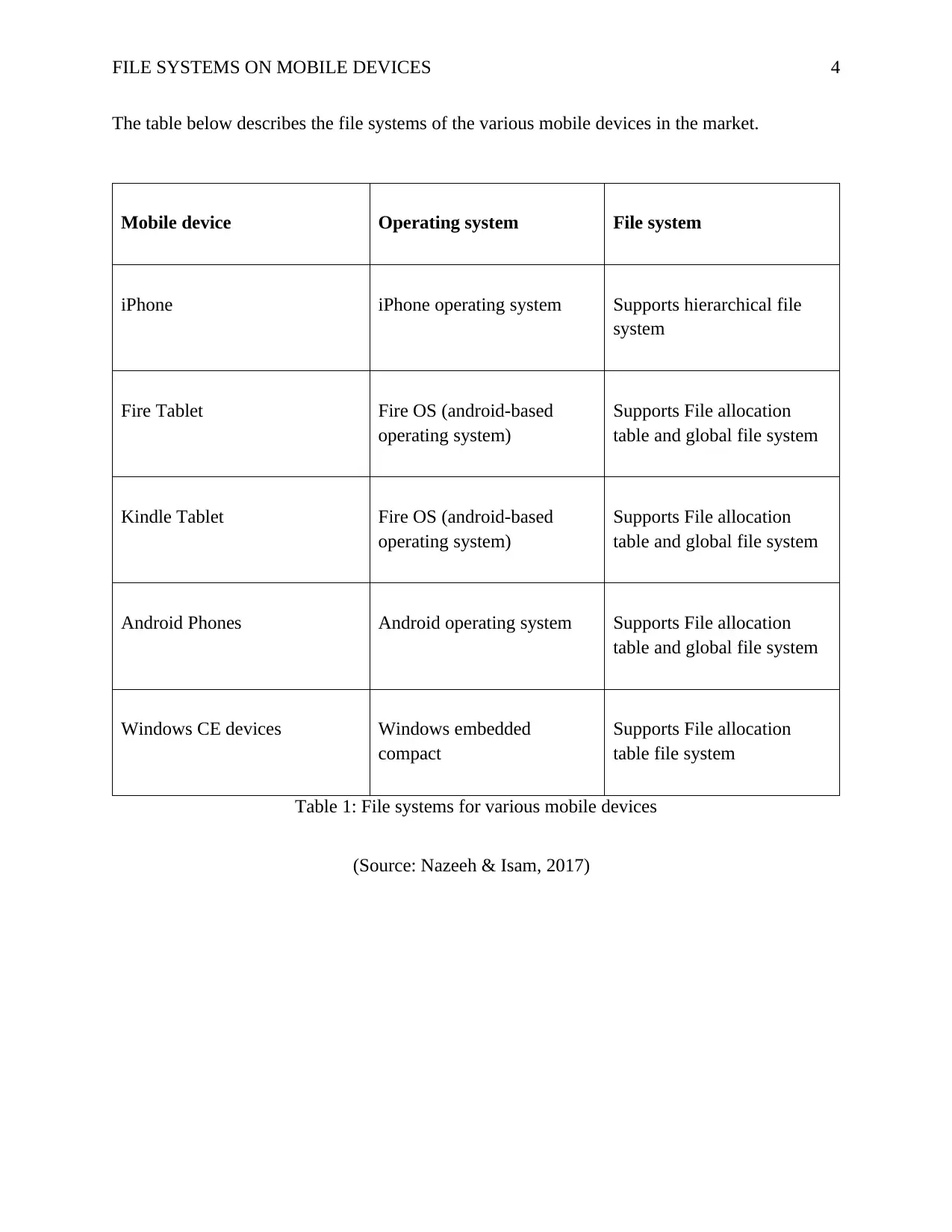
FILE SYSTEMS ON MOBILE DEVICES 4
The table below describes the file systems of the various mobile devices in the market.
Mobile device Operating system File system
iPhone iPhone operating system Supports hierarchical file
system
Fire Tablet Fire OS (android-based
operating system)
Supports File allocation
table and global file system
Kindle Tablet Fire OS (android-based
operating system)
Supports File allocation
table and global file system
Android Phones Android operating system Supports File allocation
table and global file system
Windows CE devices Windows embedded
compact
Supports File allocation
table file system
Table 1: File systems for various mobile devices
(Source: Nazeeh & Isam, 2017)
The table below describes the file systems of the various mobile devices in the market.
Mobile device Operating system File system
iPhone iPhone operating system Supports hierarchical file
system
Fire Tablet Fire OS (android-based
operating system)
Supports File allocation
table and global file system
Kindle Tablet Fire OS (android-based
operating system)
Supports File allocation
table and global file system
Android Phones Android operating system Supports File allocation
table and global file system
Windows CE devices Windows embedded
compact
Supports File allocation
table file system
Table 1: File systems for various mobile devices
(Source: Nazeeh & Isam, 2017)
Paraphrase This Document
Need a fresh take? Get an instant paraphrase of this document with our AI Paraphraser
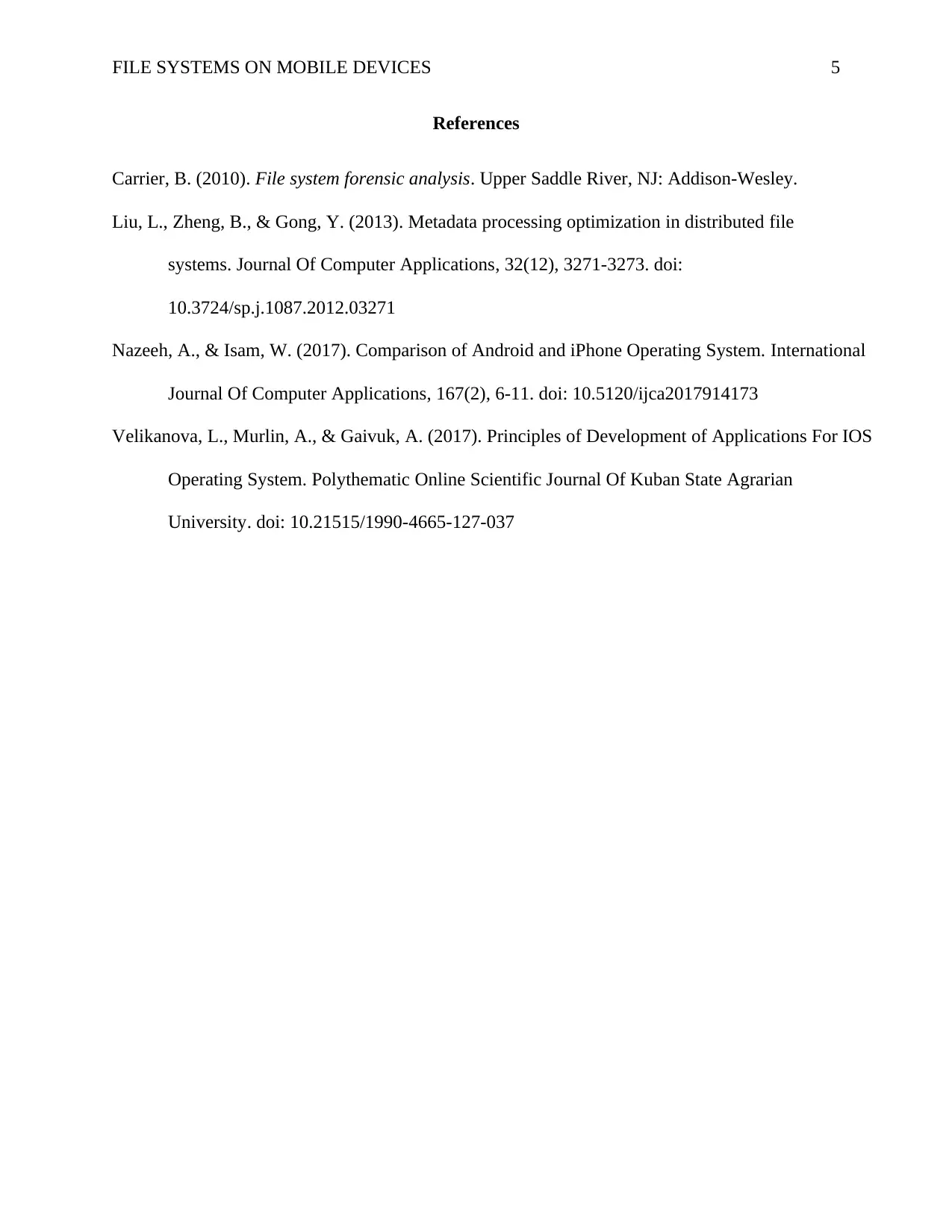
FILE SYSTEMS ON MOBILE DEVICES 5
References
Carrier, B. (2010). File system forensic analysis. Upper Saddle River, NJ: Addison-Wesley.
Liu, L., Zheng, B., & Gong, Y. (2013). Metadata processing optimization in distributed file
systems. Journal Of Computer Applications, 32(12), 3271-3273. doi:
10.3724/sp.j.1087.2012.03271
Nazeeh, A., & Isam, W. (2017). Comparison of Android and iPhone Operating System. International
Journal Of Computer Applications, 167(2), 6-11. doi: 10.5120/ijca2017914173
Velikanova, L., Murlin, A., & Gaivuk, A. (2017). Principles of Development of Applications For IOS
Operating System. Polythematic Online Scientific Journal Of Kuban State Agrarian
University. doi: 10.21515/1990-4665-127-037
References
Carrier, B. (2010). File system forensic analysis. Upper Saddle River, NJ: Addison-Wesley.
Liu, L., Zheng, B., & Gong, Y. (2013). Metadata processing optimization in distributed file
systems. Journal Of Computer Applications, 32(12), 3271-3273. doi:
10.3724/sp.j.1087.2012.03271
Nazeeh, A., & Isam, W. (2017). Comparison of Android and iPhone Operating System. International
Journal Of Computer Applications, 167(2), 6-11. doi: 10.5120/ijca2017914173
Velikanova, L., Murlin, A., & Gaivuk, A. (2017). Principles of Development of Applications For IOS
Operating System. Polythematic Online Scientific Journal Of Kuban State Agrarian
University. doi: 10.21515/1990-4665-127-037
1 out of 5
Related Documents
Your All-in-One AI-Powered Toolkit for Academic Success.
+13062052269
info@desklib.com
Available 24*7 on WhatsApp / Email
![[object Object]](/_next/static/media/star-bottom.7253800d.svg)
Unlock your academic potential
Copyright © 2020–2025 A2Z Services. All Rights Reserved. Developed and managed by ZUCOL.





